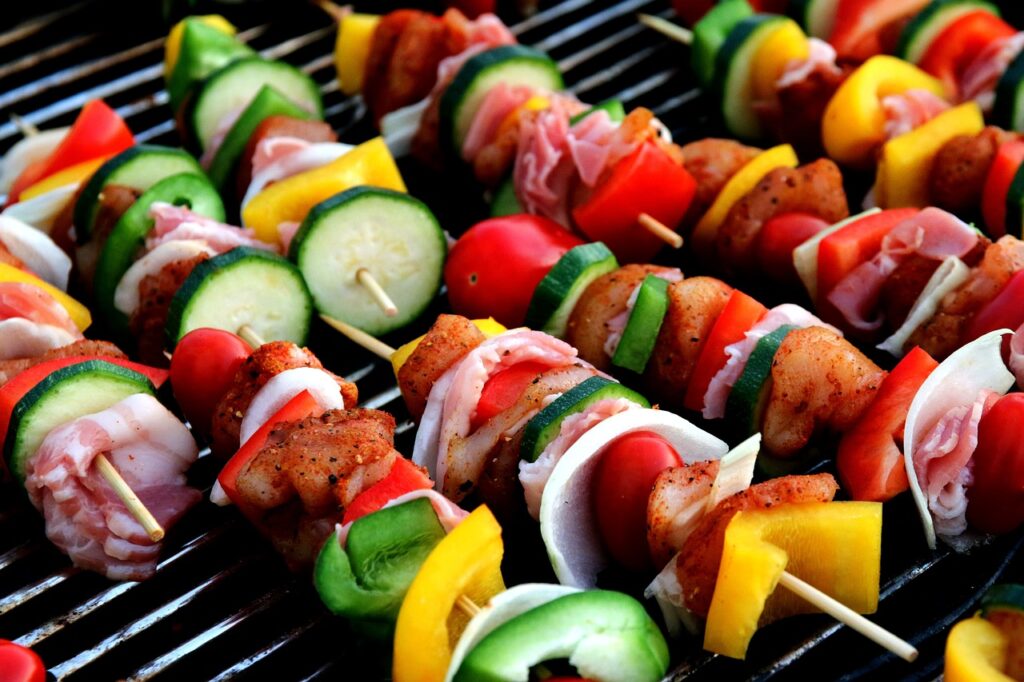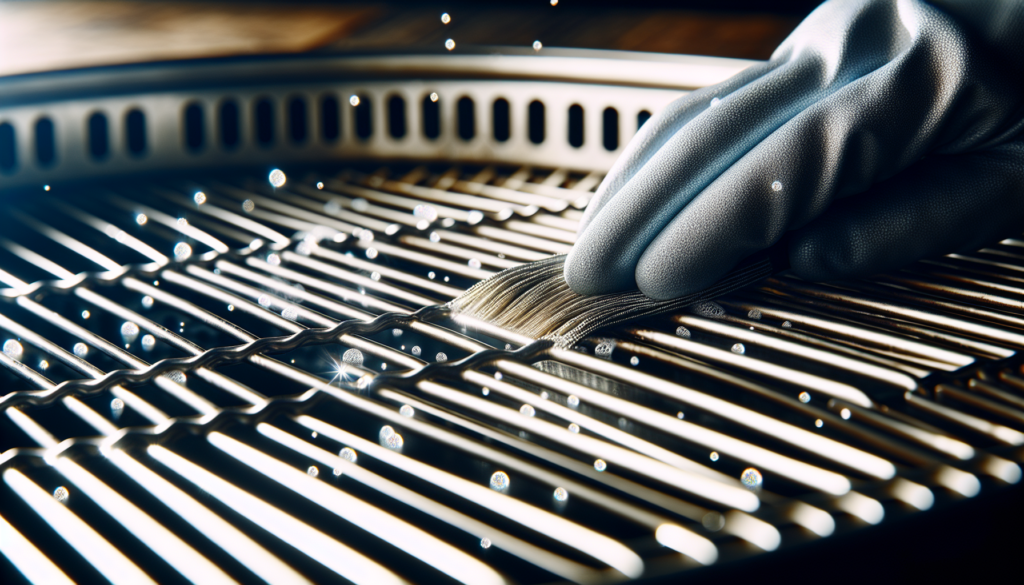Have you ever wondered how Korean BBQ grills are cleaned? Well, you’re in luck! In this article, we will take a closer look at the intriguing process of cleaning Korean BBQ grills. From the sizzling meats and flavorful aromas to the meticulous maintenance behind the scenes, you’ll gain a newfound appreciation for the sparkling clean grills that bring joy to BBQ lovers everywhere. So, prepare yourself for a fascinating journey into the world of Korean BBQ grill cleaning!

This image is property of pixabay.com.
Understanding Korean BBQ Grills
Korean BBQ grills are a popular and delicious way to enjoy a meal with friends and family. These grills come in various types and understanding them is essential for efficient cleaning. Whether you have an electric, gas, or charcoal grill, proper maintenance and regular cleaning are crucial to ensure a safe and flavorful Korean BBQ experience.
Types of Korean BBQ Grills
Korean BBQ grills come in three main types: electric, gas, and charcoal grills. Electric grills are convenient and easy to use, as they don’t require any fuel and can be used indoors. Gas grills provide quick heating and temperature control, making them a favorite for many barbecue enthusiasts. Charcoal grills offer a traditional smoky flavor and are often used in outdoor settings. Each type has its own cleaning requirements, so let’s delve into the specifics.
Importance of Regular Cleaning
Regular cleaning of your Korean BBQ grill is essential for several reasons. Firstly, it ensures food hygiene and safety, preventing the accumulation of bacteria or unwanted contaminants. Secondly, thorough cleaning helps extend the lifespan of your grill, keeping it in optimal condition. Lastly, a clean grill will enhance the taste of your food, allowing the flavors to shine through without any residue or buildup. Now, let’s dive into the step-by-step process for cleaning your Korean BBQ grill.
Pre-Cleaning Preparation
Before you begin the cleaning process, it’s important to gather the necessary tools. You will need a grill brush or scraper, a soft cleaning cloth, mild dish soap, warm water, a grease trap cleaner, and a citrus-based cleaner for stubborn stains. It’s also vital to protect the surrounding area by placing a large sheet of aluminum foil or a disposable grill liner under the grill. This will catch any falling debris and make the cleanup process much easier.

This image is property of pixabay.com.
Cleaning Process
-
Cooling Down the Grill: After you finish cooking, allow the grill to cool down completely before starting the cleaning process. This will prevent any accidental burns and make it easier to handle.
-
Removing Food Debris: Using a grill brush or scraper, remove any loose food debris from the grill grates. This step is essential to prevent the buildup of residue and unwanted flavors during future cooking sessions.
-
Scrubbing the Surface: Create a mixture of warm water and mild dish soap. Dip a soft cleaning cloth into the soapy water and gently scrub the grill grates, removing any remaining food particles or grease. Rinse the cloth frequently and continue scrubbing until the grates are clean.
-
Cleaning the Grease Trap: One of the most important steps is to clean the grease trap. This prevents the accumulation of grease, reduces the risk of flare-ups, and ensures proper ventilation. Remove the trap, empty the contents into a container, and clean it thoroughly with warm soapy water.
-
Wiping Down the Grill: After cleaning the grates and grease trap, use a clean damp cloth to wipe down the exterior surfaces of the grill. This step removes any remaining residue and gives the grill a sparkling appearance.
-
Cleaning the Ventilation Hood: If your Korean BBQ grill has a ventilation hood, it’s important to clean it regularly to maintain proper airflow. Wipe down the hood with a damp cloth and use a mild cleaner if necessary. Ensure that the ventilation system is free from any blockages for efficient operation.
Deep Cleaning
While regular cleaning is essential after each use, a deep cleaning session is recommended to thoroughly remove any stuck-on grime or grease. This deep cleaning routine should be performed every few months for optimal grill maintenance.
-
Disassembling the Grill: Start by carefully disassembling the grill, following the manufacturer’s instructions. This will allow you to clean every nook and cranny effectively.
-
Soaking and Scrubbing Grill Parts: Soak the grill grates, burners, and other removable parts in warm soapy water. This will help loosen any stubborn residue. After soaking for a while, scrub the parts with a grill brush or sponge to remove any remaining grime. Rinse them thoroughly and set them aside to dry.
-
Cleaning the Drip Tray: The drip tray is often overlooked, but it plays a crucial role in collecting grease and preventing flare-ups. Remove the drip tray and wash it with warm soapy water. Use a brush or sponge to remove any stubborn grease or residue. Rinse it thoroughly and let it air dry.
-
Cleaning the Burners: Carefully clean the burners using a grill brush or a small wire brush. Pay close attention to the small holes or slots where the flames emerge. Removing any clogs or blockages will ensure proper and even heating during future cooking.
-
Reassembling the Grill: Once all the parts are clean and dry, carefully reassemble the grill, following the manufacturer’s instructions. Double-check that everything is properly aligned and secured before you start using the grill again.

This image is property of pixabay.com.
Cleaning Tips and Tricks
Here are some additional tips and tricks to make your Korean BBQ grill cleaning more effective and efficient:
-
Using a Grill Brush or Scraper: Invest in a good quality grill brush or scraper that is specifically designed for your type of grill. This will make cleaning the grates easier and remove any stubborn residue.
-
Utilizing Citrus-based Cleaners: For tough stains or burnt-on residue, consider using a citrus-based cleaner. The natural acidity of citrus can help break down grease and grime effectively.
-
Removing Stubborn Stains: If you encounter stubborn stains that won’t come off easily, create a paste using baking soda and water. Apply this paste to the stains, let it sit for a while, then scrub it off with a brush or sponge.
-
Taking Safety Precautions: Always ensure the grill is turned off and completely cooled down before starting the cleaning process. Wear protective gloves to avoid any cuts or burns, and work in a well-ventilated area to prevent inhaling fumes from cleaning products.
-
Regular Maintenance and Inspections: Apart from regular cleaning, it’s important to perform routine maintenance and inspections of your Korean BBQ grill. Check for any loose or damaged parts, and replace them promptly to ensure safe and efficient operation.
Cleaning Frequency
To maintain a clean and functional Korean BBQ grill, it’s important to follow a regular cleaning schedule:
-
Cleaning After Each Use: After every cooking session, perform a quick cleaning of the grill grates and grease trap. This will prevent any food residue from accumulating and ensure a clean surface for the next use.
-
Thorough Cleaning Every Few Weeks: Every few weeks, perform a more comprehensive cleaning, including scrubbing the grates, wiping down the exterior surfaces, and cleaning the grease trap. This will prevent the buildup of grease and maintain optimal performance.
-
Deep Cleaning Once Every Few Months: Every few months, schedule a deep cleaning session to disassemble the grill, clean all the removable parts, and thoroughly inspect the burners and ventilation system.
-
Professional Cleaning Services: If you prefer to leave the maintenance of your Korean BBQ grill to the professionals, consider hiring a cleaning service that specializes in grill cleaning. They have the expertise and specialized tools to perform a thorough cleaning and ensure your grill is in top condition.

Ensuring Hygiene and Food Safety
Proper cleaning techniques are essential for maintaining hygiene and food safety when using a Korean BBQ grill. Here are some important considerations:
-
Proper Cleaning Techniques: Follow the manufacturer’s instructions for cleaning your specific grill model. Use food-grade cleaning products, as they are safe for use on surfaces that come into contact with food.
-
Avoiding Cross-Contamination: Always use separate utensils and cutting boards for raw and cooked meat to avoid cross-contamination. Clean and sanitize all utensils and surfaces after each use.
-
Using Food-Grade Cleaning Products: Ensure that the cleaning products you use on your grill are food-grade and safe for contact with food. This will prevent any unwanted chemical residues from affecting the taste and safety of your meal.
-
Cleaning Non-Grill Surfaces: Don’t forget to clean the surrounding surfaces, such as countertops and tables, to prevent the spread of bacteria or contamination. Use antibacterial cleaners and wipe down these surfaces regularly.
Preventing Grill Build-Up
Taking preventive measures during cooking and practicing regular maintenance can help prevent excessive grill build-up. Here are some key tips:
-
Preventive Measures During Cooking: To minimize sticking and reduce grease build-up, lightly oil the grill grates before cooking. This will create a non-stick surface and make cleaning easier afterward.
-
Using Appropriate Temperature Settings: Avoid excessive heat or flame, as it can cause food to burn and create difficult-to-clean residue. Use the appropriate temperature settings for your grill and adjust accordingly.
-
Regular Grease Trap Maintenance: Empty and clean the grease trap after each use to prevent overflowing and unwanted flare-ups. This will also maintain proper ventilation and airflow during cooking.
-
Regular Brushing While Grilling: While grilling, periodically brush the grates with a grill brush or scraper to remove any stuck-on food or excess grease. This will prevent excessive build-up and make cleaning easier once you’re done cooking.

Cleaning Challenges
Cleaning Korean BBQ grills may present some unique challenges. Here’s how to tackle them effectively:
-
Burnt-on Residue: For stubborn burnt-on residue, soak the affected area in warm soapy water or a citrus-based cleaner. Let it sit for some time to loosen the residue, then scrub it off with a grill brush or scraper.
-
Removing Stubborn Stuck-on Food: For stubborn stuck-on food, a mixture of baking soda and water applied as a paste can be very effective. Let it sit for a while to dissolve the residue, then scrub it off.
-
Cleaning Hard-to-Reach Areas: Use small brushes, such as toothbrushes or pipe cleaners, to reach and clean hard-to-reach areas. This ensures that no grease or residue is left behind.
-
Handling Rust or Corrosion: If you encounter rust or corrosion on your grill, gently scrub the affected area with a wire brush or steel wool until the rust is removed. Apply a rust-resistant paint or spray to prevent further corrosion.
Conclusion
Understanding how to clean Korean BBQ grills is essential for maintaining optimal performance, food safety, and overall enjoyment. Regular cleaning, both after each use and through deeper cleaning sessions, ensures a clean and flavorful grilling experience. By following the outlined cleaning process, utilizing helpful tips and tricks, and practicing preventive measures, you can keep your Korean BBQ grill in top shape for years to come. So, roll up your sleeves, grab your cleaning tools, and get ready to enjoy safe and delicious Korean BBQ!
